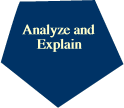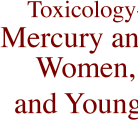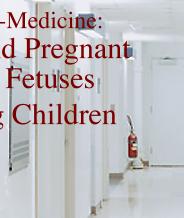 |
|||
 |
||||
CALENDAR |
||||||||||||||
HOME |
||||||||||||||
Mercury
Clean Air Act (CAA) industrial mercury emissions control: creation of mercury hot spots? Can Hg emission credits be traded like those for gaseous emissions (carbon dioxide)?
Recent research of relationship between autism risk and industrial mercury hot spots raises questions about affect of trading emission credits on creations of Hg hot spots .
The joint EPA-FDA Advisory on mercury and fish consumption: what it says and does not; what it means and does not. Clearing up the confusion [see . Guidelines, fact sheets and frequently asked questions [see Toxicology & the Home].
New research on low level neurotoxic effects of mercury: scientific evidence on both sides of the controversy [see Toxicology of Science].
EPA responds to petitions from States, Environmental Groups and Indian tribes to reconsider changes to the CAA that would allow cap trading of mercury releases. Review events leading up to recent development. Public comments invited (deadline for comments was December 17, 2005).

Exposure Assessment
A margin-of-error factor of ten is then applied to the 58 ug/L to get the RfD of 5.8 ug Hg/L blood (5.8 ppb), or 0.1 ug/kg bw/day of mercury consumed. This factor of ten was judged to be the correct one for this RfD. The study includes a factor of 2-3 for inter-individual variability in the processing of mercury in the body, from maternal hair measurements or cord blood measurements. And an additional factor of 3.5 for uncertainty about the data or missing data. Available data suggests that mercury exposure can also cause immunological and cardiovascular deficits during development, at perhaps concentrations below the benchmark level for neurotoxic effect, so this takes that into account.
It’s also important to note that these reference doses do not account for mercury exposure from other sources such as inhalation, or dental amalgams, as well as any additive or exacerbating effect of other heavy metal exposure, such as lead (which also exerts neurotoxic effects).
This RfD was further verified by other analyses and data. As reported in IRIS, when part of the cohort with 10 ppm hair mercury (40 ug/kg/day) or more were removed a dose response was still evident for the lower concentrations of mercury, strongly supporting an effect at doses below these cut off points. Since the RfD is 5.8 ug/kg/day, this means that effects were seen at levels less that 5-6 times the RfD, leaving very little margin of error, especially when it is estimated that 1-3 percent of women consume amounts of fish that produces a mercury level 3.5 times the RfD (NAS, 2000). The Faroe Island study showed no threshold effect.
A second Faroe Island cohort study, of children born in 1994-1995 (Steurwald et al, 2000) showed a dose related decrement in neurologic optimality scores (NOS) from less than 10 ug Hg / L blood to greater than 40 ug Hg/L blood. This shows effects at levels less than 60 percent of the RfD, rather than a ten-fold (1000 percent) margin of safety. As many as six percent of pregnant women (approximately 240, 000 of the 4, 000,000) are above the RfD for mercury and of those, approximately one to 1.5 percent of pregnant women (40, 000 – 60, 000 live births per year) are as much as 3.5 times above the RfD (blood mercury levels of 20 ug/L), primarily due to fish consumption levels.
As stated in the National Academy of Sciences 2000 report (p. 325):
The MeHg-associated performance decrements on the neuropsychological tests administered in the Faroe Islands and New Zealand studies suggest that prenatal MeHg exposure is likely to be associated with poorer school performance. In the Faroe Islands sample, MeHg-related deficits were seen across a broad range of specific domains, including vocabulary, verbal learning, visuo-spacial attention, and neuromotor function. Deficits of the magnitude reported in these studies are likely to be associated with increases in the number of children who have to struggle to keep up in a normal classroom or who might require remedial classes or special education.
Although the fraction may be considered small compared to the total population, the numbers, 40, 000 – 240, 000, at risk for neuro-developmental deficits that could compromise general functioning and school work, is substantial. It’s important for everyone to know what is at issue, what the risks are and what one can do.
Again, the 5.8 ug Hg/L blood is comparable to 0.1 ug Hg/kg bw/day, or 0.7 ug Hg/kg bw/week. For a 130 pound woman (59 kg), this translates to 0.7 ug/kg X 59 kg, or 41 ug Hg per week. A 33 pound baby, or 15 kg would be allowed 10.5 ug/week Hg. A six ounce can of chunk light Tuna (170 gms) has an average mercury concentration of 0.12 ppm (ug/g), or 170 X 0.12 = 20 gms of mercury. The 130 pound woman could eat two cans per week; the 33 pound baby could eat one can every two weeks. White Albacore Tuna contains 0.353 ppm (ug/g) mercury, or 170 X 0.353 = 60 ug mercury per six ounce can. The woman could eat two-thirds can per week, or approximately three cans per month; the baby could eat one-quarter can per week or one can per month. These calculations include no other sources of mercury, nor do they take into account other risk factors or nutritional disturbances, such as a deficit of selenium, which can assist in the detoxification of mercury.
References:
Davidson PW, Myers GH, Cox C et al (1995) NeuroToxicology 16:677-88
Davidson PW, Myers GH, Cox C et al (1997) JAMA 280:701-07
Grandjean P, Weihe P, White R et al (1997) Neurotoxicol Teratol 20:1-12
Kjellstrom T, Kennedy P, Wallis, S et al (1986) Natl Swed Environ Prot Bd, Rpt 3080
Kjellstrom T, Kennedy P, Wallis, S et al (1989) Natl Swed Environ Prot Bd, Rpt 3642
Myers GH, Marsh, DO, Cox, C et al (1995) Neurotoxicology 16:629-38
Myers GH, Davidson PW, Shamlaye CF et al (1997) Neurotoxicology 18:819-30
National Research Council (2000) National Academy Press, Washington DC
Steurwald U, Weibe P, Jorgensen K (2000) J Pediatr 136:599-605



